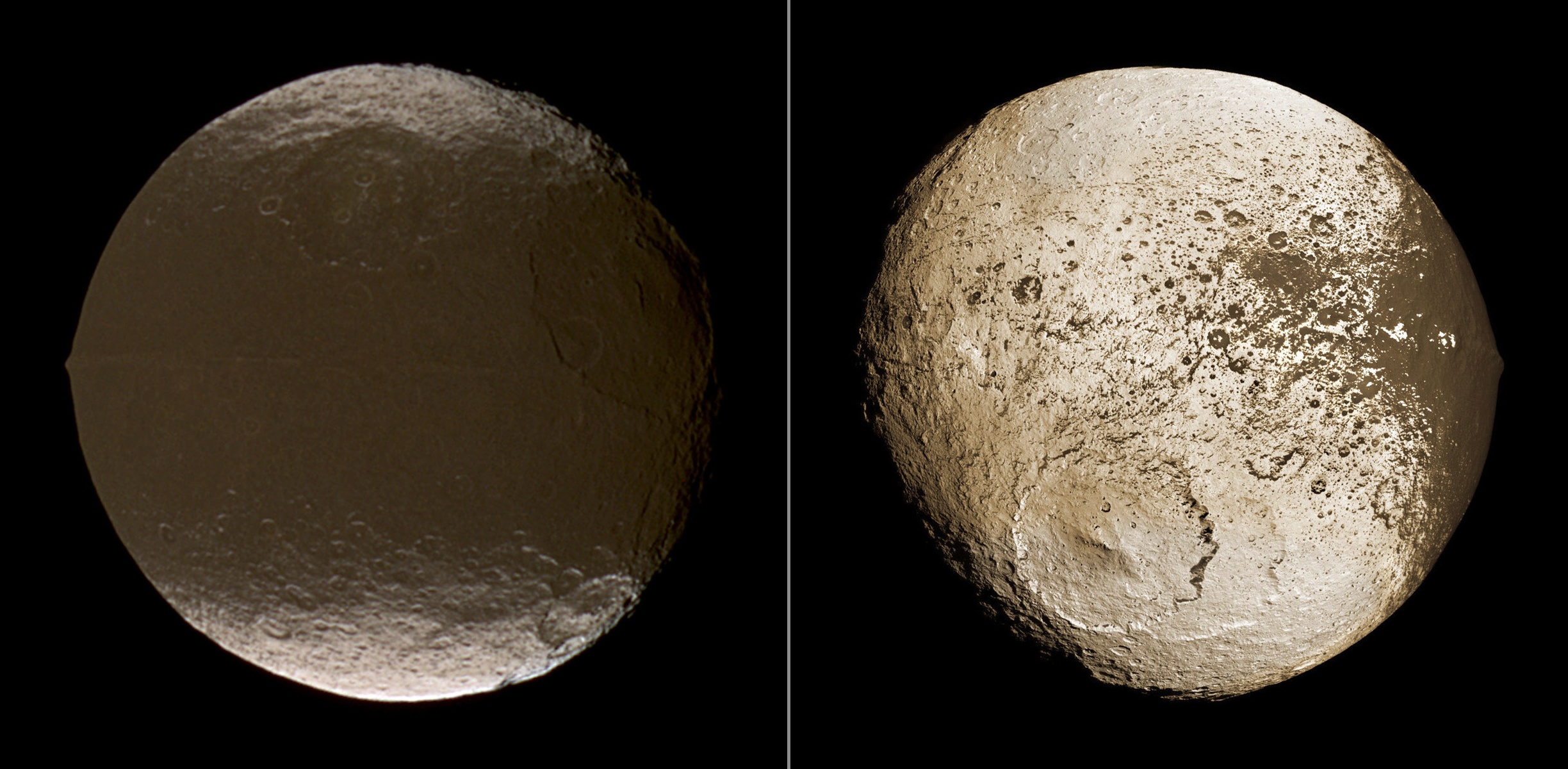Clues to 'Weird' Saturn Moon Found in Earth's Ice

Astronomers hoping to shed light on how Saturn's "weird" moon Iapetus developed over time are taking cues from climate research of icy surfaces right here on Earth.
Iapetus' bizarre two-toned appearance — with one dark side and one bright side — has puzzled astronomers since the moon was first discovered by Giovanni Domenico Cassini in 1671. To better understand how this oddball Saturn moon formed and evolved, researchers are now studying the temperature variation across Iapetus' differing surfaces by measuring the moon's microwave emissions.
Previous studies using data from NASA's Cassini spacecraft suggest that migrating ice makes half of Iapetus reflective and bright, while the other side is cloaked in dust and darkness.
"What makes Iapetus unusual is that it has one side that is dark and one side that is bright," said Paul Ries, a graduate student at the University of Virginia and a researcher at the National Radio Astronomy Observatory (NRAO). "There have been a couple attempts to look at the variation in temperature across the surface, but no one has actually done a rotational light curve. I was trying to get something continuous to look at the thermal variations."
To do this, Ries measured the amount of light produced by Iapetus and its pattern of microwave emissions. Essentially, most objects in the solar system are blackbody objects that absorb all the radiation that hits them, he explained. [Photos of Saturn's Moons]
"They follow this pattern of emission called a Planck curve, and as you go to longer wavelengths — infrared to radio — you have declining emissions," Ries told SPACE.com.
But Ries' observations of Iapetus showed a very different and unexpected pattern.
Breaking space news, the latest updates on rocket launches, skywatching events and more!
"What I found was that the emissions were what we call flat, which means that as you go from one radio wavelength to another, the emissions were the same when you expect them to be declining," Ries said. "What that corresponds to is a very steep absorption. I was expecting to find something, but I was not expecting to find something quite so strong."
To improve his models of Iapetus, Ries looked a little closer to home, at previous studies that measured microwave emissions and temperature signals from our own planet.
"It turns out that there's a lot of work in climate science with modeling the radio emissions from Earth at a wide range of wavelengths," Ries said. "This is important to astronomers because they're at wavelengths that are transparent, where you don't have too much interference from the atmosphere. My thought was: why not try to use the icy surfaces on Earth to model icy surfaces on bodies in the outer solar system?"
Land areas on Earth mostly follow the Planck curve, and scientists are able to translate microwave emissions into temperature signals without too much trouble, he explained. But, there are two main complications: oceans and ice.
"Salinity content changes the microwave emission properties of oceans," Ries said. "The other area of interest is icy surfaces, which can vary depending on the structure of the ice. If there's melting, the signature changes drastically, which is why climate scientists have done some extensive studies of emissivity variations in the microwave spectrum."
But ice on Earth behaves differently compared to ice in space, particularly as it melts into liquid water, he added.
"You can't have liquid water on a body with no atmosphere, which is what we think of Iapetus," Ries said. "If there's any gas hanging around, it's not hanging around for long. That's true for most of the icy bodies in the outer solar system, such as Kuiper Belt objects. You don't expect them to have an atmosphere, so there's no liquid water involved."
Ries is incorporating these limitations into his model, and he also plans to scrutinize how the size of the ice grains and their distribution affects measurements of a body's microwave emissions.
Still, the research represents a novel approach that Ries hopes to apply to studying other celestial bodies, such as the moons around Jupiter, asteroids and other objects in the Kuiper Belt, which is a zone beyond the orbit of Neptune.
"In the specific case of Iapetus, it can help shed light on what's going on in its formation and evolution," Ries said. "Iapetus certainly has some strange stuff that needs to be explained, so this is potentially very interesting for the future. But eventually, I'd like to do observations of the outer solar system — the Kuiper Belt and beyond."
You can follow SPACE.com staff writer Denise Chow on Twitter @denisechow. Follow SPACE.com for the latest in space science and exploration news on Twitter @Spacedotcom and on Facebook.

Denise Chow is a former Space.com staff writer who then worked as assistant managing editor at Live Science before moving to NBC News as a science reporter, where she focuses on general science and climate change. She spent two years with Space.com, writing about rocket launches and covering NASA's final three space shuttle missions, before joining the Live Science team in 2013. A Canadian transplant, Denise has a bachelor's degree from the University of Toronto, and a master's degree in journalism from New York University. At NBC News, Denise covers general science and climate change.
